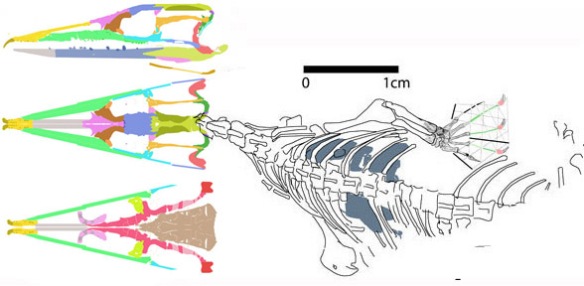We’re getting back
to an older series today as we ‘play’ with the large reptile tree (1262 taxa, LRT) by cherry-deleting taxa.
Drepanosauromorpha are so distinct from other reptiles
that experts have been hard at work trying to figure out what they are—without success or consensus. There are so many competing ideas (which means none are convincing) that I’m going to refer you to the Wikipedia page on Drepanosauridae that lists and discusses them all with citations. The latest work (Pritchard and Nesbitt 2017) recovered a very basal diapsid nesting, but they did not realize that lepidosaur ‘diapsids’ were not related to archosaur ‘diapsids’, due to taxon exclusion at the genesis of reptiles.

Figure 3. Drepanosaurs and their ancestor sisters, Jesairosaurus and Palaegama to scale.
Unfortunately,
all prior workers omitted or overlooked the widely tested closest relatives, Jesairosaurus (Jalil 1997, Fig. 1) followed by the basal lepidosauriformes, Tridentinosaurus, Lanthanolania, Sophineta and Palaegama (Fig. 1) in the LRT, which tests all prior sister candidates Megachirella (Fig. 2), at the base of the Rhynchocephalia (Fig. 3), is also closely related in the LRT. So, once again, taxon exclusion is the problem in all prior studies. Jesairosaurus was documented as the last common ancestor of drepanosauromorpha here in October 2012. This is not one of those “obvious as soon as you realize it” nestings. You really do need the wide gamut testing of the LRT to eliminate all other candidates.

FIgure 2. Megachirella (Renesto and Posenato 2003) is a sister to the BSRUG diapsid.
So let’s play the game of taxon exclusion…
If Jesairosaurus and all Archosauromorpha are deleted,
the remaining drepanosauromorphs do not shift to another node within the Lepidosauromorpha.
If Jesairosaurus and Hypuronector and all Archosauromorpha are deleted,
the remaining drepanosauromorphs do not shift to another node, and nest with basalmost Sphenodontia, like the BSRUG 29950-12 specimen related to Megachirella and Pleurosaurus.
If Lepidosauromorpha and Diapsida are deleted,
Jesairosaurus and the drepanosauromorphs nest with the herbivorous synapsids, Suminia and Dicynodon.
If Lepidosauromorpha and Diapsida are deleted,
Megalancosaurus alone nests between the herbivorous synapsids Venjukovia + Tiarajudens and Suminia + Dicynodon.

Figure 3. Subset of the LRT focusing on basal lepidosauriformes and Jesairosaurus at the base of the Jesairosauria. Several new clades are named here.
If only Diapsida is tested,
Jesairosaurus and the remaining drepanosauromorphs nest as a clade between the sauropterygians and mesosaurs + thalattosaurs + ichthyosaurs.
If only Diapsida is tested,
Megalancosaurus alone nests between the sauropterygians and mesosaurs + thalattosaurs + ichthyosaurs.
Nomenclature and some suggestions:
- Jesairosauria — Jesairosaurus, Megachirella, their last common ancestor all descendants. More taxa reveal this phylogenetic pattern that has, so far, escaped the notice of professional paleontologists.
- Rhynchocephalia — Gephyrosaurus, Megachirella, their last common ancestor all descendants.
- Sphenodontia — Sphenodon, Ankylosphenodon, their last common ancestor all descendants.
- Transphenodontia — Trilophosoaurus, Mesosuchus, their last common ancestor all descendants. These taxa bridge the gap between sphenodonts and rhynchosaurs and include the latter. More taxa reveal this phylogenetic pattern that has, so far, escaped the notice of professional paleontologists.
- Rhynchosauria — Rhynchosaurus, Hyperodapedon, their last common ancestor all descendants.
- Pseudoribia — Coelurosauravus, Icarosaurus, their last common ancestor all descendants. These so-called ‘rib-gliders’ actually use elongate dermal ossifications to extend their gliding membranes. More taxa and a closer examination of Icarosaurus and kin reveal this clade that has, so far, escaped the notice of professional paleontologists.
The related taxa shown
in figure 3 as a subset of the large reptile tree come together by way of taxon inclusion. Prior workers missed these relationships by excluding taxa. Rhynchosaurs were once considered Rhynchocephalians, but recently that has not been accepted based on the invalidated hypothesis that rhynchosaurs were archosauriformes.
Invalidated or modified nomenclature:
- Allokotosauria — While protorosaurs, including Pamelaria, are basal members of the new Archosauromorpha, Trilophosaurus and Azendohsaurus are members of the new Lepidosauromorpha.
- Diapsida — The LRT documents two unrelated clades evolving diapsid skull architecture. In the LRT only archosauromorph diapsids are considered Diapsida. More taxa reveal this pattern that has, so far, escaped the notice of professional paleontologists.
I hope readers enjoy and learn from these daily blogs.
If you disagree with any of the results, I encourage you to run your own tests with similar taxon lists, then let us all know if you confirm or refute the LRT results. Don’t be like those who just hurl adjectives at the work done here. Keep up your professional demeanor and attitude and be prepared to accept new discoveries if they cannot be refuted. The strength of the LRT is that is covers all available candidates and minimizes taxon exclusion problems that plague smaller prior studies.
References
Jalil N-E 1997. A new prolacertiform diapsid from the Triassic of North Africa and the interrelationships of the Prolacertiformes. Journal of Vertebrate Paleontology 17(3), 506-525.
Pritchard AC and Nesbitt SJ 2017. A bird-like skull in a Triassic diapsid reptile increases heterogeneity of the morphological and phylogenetic radiation of Diapsida. Royal Society Open Science DOI: 10.1098/rsos.170499
